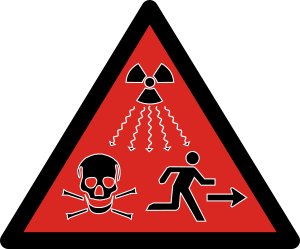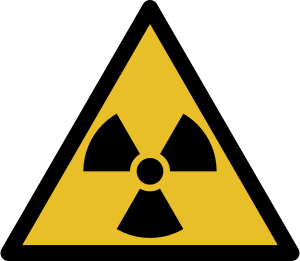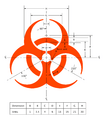ISO 21482 facts for kids
ISO 21482 is a special standard that describes a new warning sign. This sign helps warn people about the dangers of radiation. Radiation is a type of energy that can be harmful if you are exposed to too much of it.
The new warning sign has a few important parts. At the top, you see the familiar trefoil symbol. This symbol has always warned about radiation. Below that, there are lines pointing downwards. On the bottom left, there is a skull. This part warns about poison or death. On the bottom right, you can see a running person with an arrow pointing away from the sign. This tells you to move away from the danger. The color red was chosen for the symbol because kids said it looked more dangerous than yellow. A group called the Gallup Organization suggested this symbol after showing it to many people.
Contents
What is the New Radiation Symbol?
The new ISO 21482 symbol does not replace the old radiation symbol. Instead, it works with it to make warnings even clearer. It was created to help people understand the danger of radiation. This is especially true for those who might not know what radiation is or what the old symbol means.
Why Was a New Symbol Needed?
This new symbol was developed because of past accidents involving radioactive materials. For example, in 1987, there was an accident in Goiânia. Another incident happened near Bangkok in 2000. In these cases, people accidentally opened containers with dangerous radioactive materials. The new symbol aims to prevent similar accidents by making the danger very clear.
Where Will You See It?
The new symbol will not be placed on the outside of containers. Instead, it will go directly on the most dangerous radioactive materials themselves. These are the strongest types of radioactive substances, known as categories 1 to 3. Containers will still only have the old radiation symbol. This is because the containers themselves are not directly dangerous. Rooms that have radiation sources or x-ray equipment will also continue to use only the old symbol.
Images for kids




